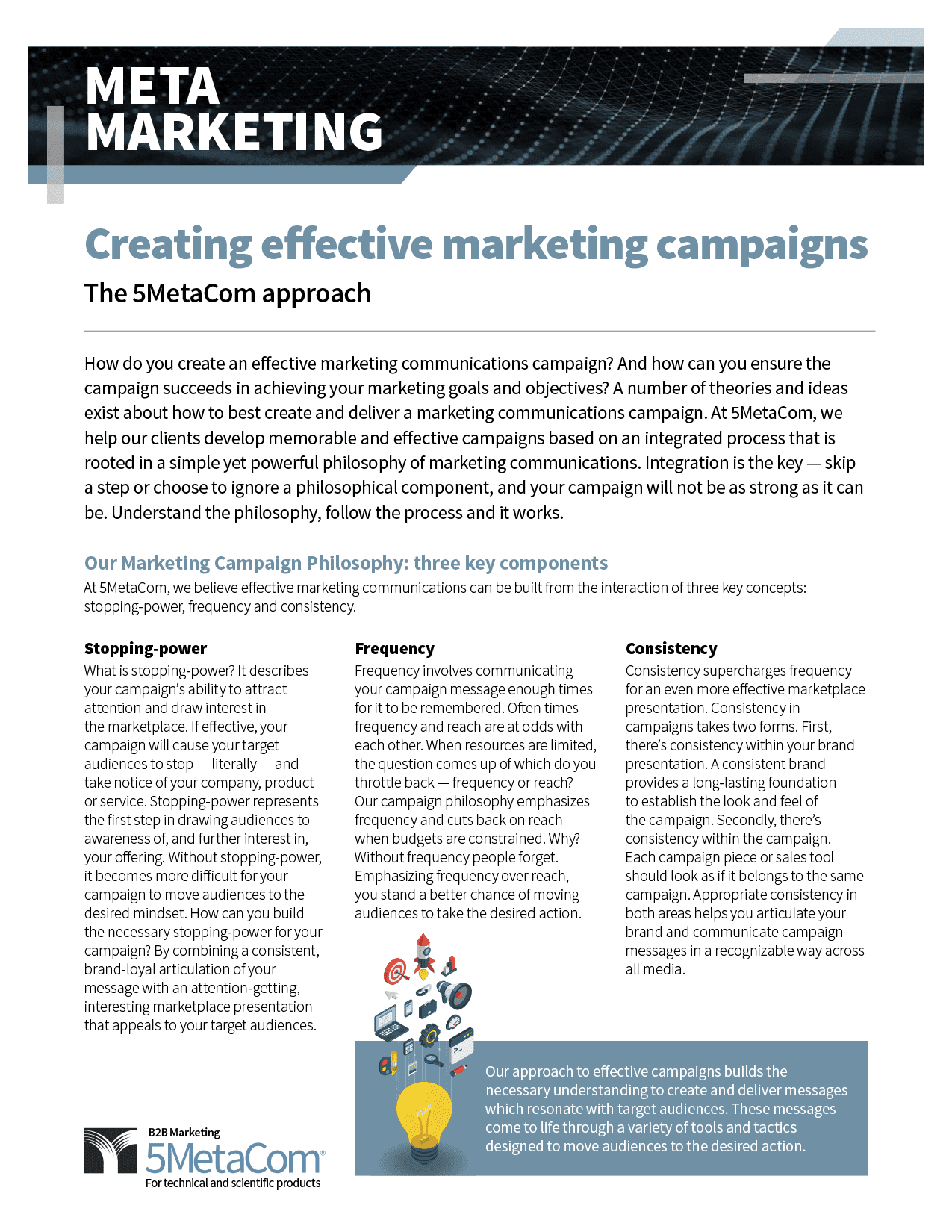Creating effective marketing campaigns
The 5MetaCom approach
How do you create an effective marketing communications campaign? And how can you ensure the campaign succeeds in achieving your marketing goals and objectives? A number of theories and ideas exist about how to best create and deliver a marketing communications campaign. At 5MetaCom, we help our clients develop memorable and effective campaigns based on an integrated process that is rooted in a simple yet powerful philosophy of marketing communications. Integration is the key — skip a step or choose to ignore a philosophical component and your campaign will not be as strong as it can be. Understand the philosophy, follow the process and it works.
Our Marketing Campaign Philosophy: three key components
At 5MetaCom, we believe effective marketing communications can be built from the interaction of three key concepts: stopping-power, frequency and consistency.
STOPPING-POWER
What is stopping-power? It describes your campaign’s ability to attract attention and draw interest in the marketplace. If effective, your campaign will cause your target audiences to stop—literally—and take notice of your company, product or service. Stopping-power represents the first step in drawing audiences to awareness of, and further interest in, your offering. Without stopping-power, it becomes more difficult for your campaign to move audiences to the desired mindset. How can you build the necessary stopping-power for your campaign? By combining a consistent, brand-loyal articulation of your message with an attention-getting, interesting marketplace presentation that appeals to your target audiences.
FREQUENCY
Frequency involves communicating your campaign message enough times for it to be remembered. Oftentimes frequency and reach are at odds with each other. When resources are limited, the question comes up of which do you throttle back—frequency or reach? Our campaign philosophy emphasizes frequency and cuts back on reach when budgets are constrained. Why? Without frequency, people forget. Emphasizing frequency over reach, you stand a better chance of moving audiences to take the desired action.
CONSISTENCY
Consistency supercharges frequency for an even more effective marketplace presentation. Consistency in campaigns takes two forms. First, there’s consistency within your brand presentation. A consistent brand provides a long-lasting foundation to establish the look and feel of the campaign. Secondly, there’s consistency within the campaign. Each campaign piece or sales tool should look as if it belongs to the same campaign. Appropriate consistency in both areas helps you articulate your brand and communicate campaign messages in a recognizable way across all media.

Our approach to effective campaigns builds the necessary understanding to create and deliver messages which resonate with target audiences. These messages come to life through a variety of tools and tactics designed to move audiences to the desired action.
The Marketing Campaign Process
Five steps to more effective communications
At 5MetaCom, we’ve developed a process for effectively communicating about technical and scientific products and services. By performing the following five steps, we’re confident your marketing campaign has a better chance of successfully meeting your goals and objectives.

STEP 1: DISCOVERY
Discovery involves conducting interviews and gathering background and marketplace information to gain an understanding of where you are and where you want to go. The Discovery process includes asking questions inside and outside your organization to clearly identify who to communicate with and how to best communicate with that audience. In addition, Discovery helps identify issues, trends, strengths, weaknesses and opportunities in the marketplace.

STEP 2: ENVISIONING
The second step, Envisioning, develops and defines the strategies and other essential components that form the basis of realizing your goals. In Envisioning, several fundamentals take shape and can vary by campaign, such as:
- Evaluate the mindsets of target audiences.
- Create campaign strategies to best position your company, product or service in the marketplace.
- Develop a positioning statement to communicate what your company, products and/or services do and who they are for.
- Develop messages to communicate your position. 5MetaCom uses the 3-30/3-30 brand message platform to deliver communication clarity across audiences and ensure consistency.
- Test campaign messages (potentially) to determine if they draw audiences to the desired mindset.
- Establish a practical and meaningful way to measure and evaluate campaign outcomes (in Step 5).
- Plan the tactical delivery of those messages into the marketplace by identifying various campaign vehicles.

STEP 3: EXPRESSION
This step of the process transforms the messages created in Envisioning for marketplace introduction and exposure. Expression results in a brand-loyal articulation of campaign messages. These messages intend to attract attention, build interest, foster understanding and ultimately lead to adoption by target audiences. Typically, Expression involves development of a cornerstone piece. The cornerstone piece can take the form of a brochure, print advertisement or other communications vehicle. The cornerstone piece represents the key creative work. This step establishes the creative foundation including graphic style (colors, typography) and copy platform (message, tone, key copy points). This step of the process includes the option to perform testing to identify the strongest candidate among a number of concepts or creative ideas.

STEP 4: MOBILIZATION
Mobilization is the process of delivering campaign messages to target audiences. In Mobilization, the Expression (established in Step 3) is adapted for many different forms of media. A variety of tools and tactics may be evaluated, created and selected to promote the campaign.
To better understand how Mobilization works, think of this step of the campaign process as a system. The set of tactics works together as a system to lead target audiences to a desired action. Each tactic within Mobilization has a specific objective and intended use within that system. Usually, no two tactics have been developed to perform the same function.
How does creating a campaign differ from building a brand?
Campaigning and branding may seem similar. Campaigns actually function as a subset of the brand. A campaign can take the form of something as simple as a product introduction or price promotion. As a result, campaign materials may have limited use and therefore are considered disposable.
Branding represents a bigger, more permanent activity that tends to evolve slowly over time. The brand guides the look and feel of your marketplace presentation.
